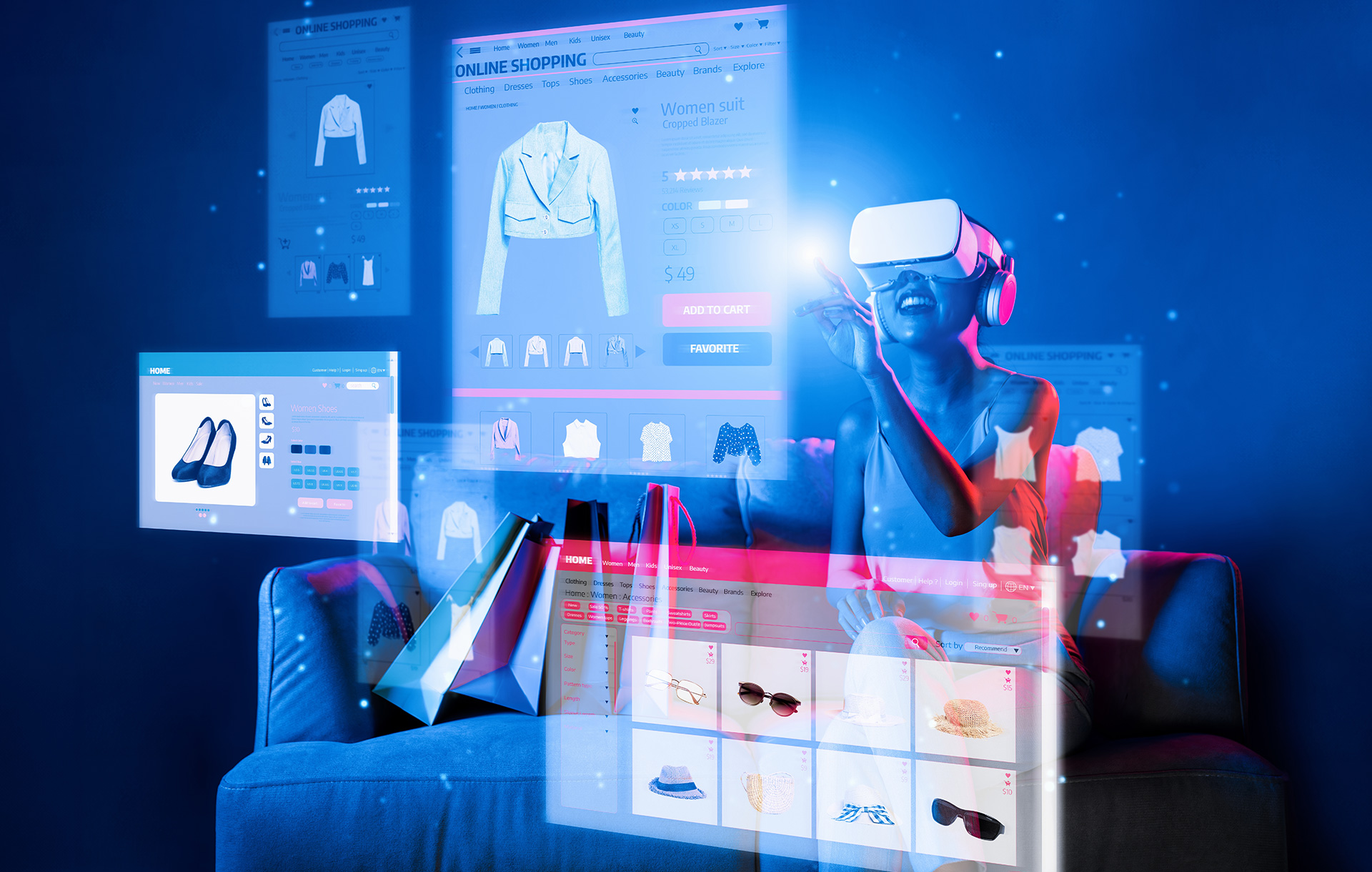Retail Web Trends 2023: How Retail Brands Websites Must Be Refashioned
Change is, and always will be, a key element to the fashion industry’s identity. Year by year, season by season, fashion never stays still, therefore, neither should your retail brand, as the importance of understanding future retail website trends cannot be overstated.
Consumer behaviour post-pandemic and the likely eCommerce trends 2023 will throw up are directly linked to the success of your retail brand. This is particularly important for fashion eCommerce, as the current trends drive a thriving industry on track to reach a value oaQ1f $1.2 trillion by 2025. However, the year ahead may bring about the industry’s most drastic transformation yet, making the consumer products trends 2023 will take on an added significance.
As consumers and fashion retailers alike look to navigate the aftermath of the COVID-19 pandemic, and the current economic crisis, future retail website trends are crucial to success. eCommerce fashion is likely to continue its growth, with customers enjoying the convenience associated with it.
Instead, we’ll see a growing market for seasonless items as consumers look to make the most out of each purchase after many have been affected by a financial downturn, while retail shopping websites in 2023 need to make sure they are optimised for business. Online shopping trends statistics show that this is especially important when you consider that retail websites have the highest average pages per session out of any sector, so you’ll want to make the most of this.
The past few years have brought about enormous changes to everyone, but in particular to business owners. It has led to a whole host of new consumer behaviours and trends that will continue into 2023 and beyond, which we will discuss and explain in this post.
The Changing Retail Landscape
The retail landscape has undergone significant changes in recent years, with a significant shift towards online retail. This trend has been accelerated by the COVID-19 pandemic, as consumers increasingly turn to online shopping to avoid crowded stores and reduce the risk of infection.
With that in mind, let’s highlight some of the main changes that have happened to the retail landscape:
Rise of E-commerce
One of the most significant changes has been the rise of e-commerce, driven by the increasing use of the internet and smartphones. Online shopping has become more convenient, affordable, and accessible, which has led to a decline in traditional brick-and-mortar stores.
Changing Consumer Preferences
Consumers have become more demanding in terms of the products they purchase, the way they shop, and the overall shopping experience. They are looking for more personalised, convenient, and socially responsible shopping experiences.
Growth of Omnichannel Retailing
Retailers are responding to changing consumer preferences by adopting omnichannel retailing strategies. This involves integrating online and offline channels to create a seamless shopping experience for consumers.
Use of Technology
Technology has played a significant role in the changing retail landscape. Retailers are using technologies such as AI, machine learning, and data analytics to gain insights into consumer behaviour and provide a more personalised shopping experience.
Increasing Competition
Competition in the retail industry has increased significantly in recent years, with the rise of online marketplaces and the entry of new players. This has put pressure on retailers to innovate and differentiate themselves in order to stay competitive.
Changing Demographics
Demographic changes, such as the ageing population and the growth of millennials, have also had an impact on the retail landscape. Retailers are adapting to the changing needs and preferences of different demographic groups to remain relevant and competitive.
Changes in Consumer Behaviour Require Website Adaptations
The recent growth of eCommerce as a result of the pandemic has accelerated trends that we were already noticing. This has meant retailers have had to upgrade their online presence, offering online sales channels, omniplatform services and focus on their social media accounts as a form of communication. Brands that are able to offer this, and continue to develop it, will be able to compete throughout 2023, regardless of any new economic-related issues.
It’s not just eCommerce-focused retailers that need to be ready to further adapt. Companies with a physical store should look to create a seamless omnichannel experience too, making sure that all touch points remain on-brand, giving customers an enjoyable shopping experience whether they shop online, in-store, or using a combination of the two.
There has never been a more important time to focus on technology and eCommerce to help encourage positive consumer behaviour post-pandemic. It’s worth looking at the technology available that can improve customer experience, streamline operations and enable your business to grow with peak online shopping expected to be 50% higher next year, highlighting the importance of retailer’s online presence.
With more consumers shopping online than ever before, your website needs to be able to deal with increased demand, as well as provide customers with all of the information that they need to shop seamlessly and successfully while incorporating the likely trends they are looking for in the year ahead.
Retail Web Trends For Brands In 2023
Every year both retail and online trends change and evolve. With every change, retailers need to focus on accessibility and identity, engage new audiences with technology and embrace new online trends, such as these five retail web trends 2023:
Social Commerce: This year’s surge in online shopping will continue into 2023, especially given the ongoing problems COVID-19 keeps presenting, including the consequential economic fallout, along with the widespread closure of brick-and-mortar stores. In fact, 41% of customers stated that they were now shopping online for things they would typically buy in-store. This is where social commerce becomes a factor.
Social commerce is a native shopping experience on a social media platform, offering shoppers a seamless way to shop online, that’s even more direct than usual. Instead of clicking through to a third-party website, users can make purchases right from the social media app or site itself, such as Instagram. There have also been partnerships between TikTok and Shopify, an expansion of Snapchat’s Native Stores for brands, and the introduction of Facebook Shops. When paired with the growing influencer marketing campaigns, 2023 will see social commerce become an even more integral part of the eCommerce experience for brands and shoppers alike, reducing the number of clicks and decisions needed to make a purchase.
AI Chatbots: With more shoppers purchasing from retailers that align with their values, personalisation, consumer convenience, and the act of relevancy are growing trends across all eCommerce industries. To help deal with this influx of online customers, eCommerce retailers are increasingly turning to AI and chatbots. Brands such as ASOS, Burberry, Levi’s, and Tommy Hilfiger have all adopted retail chatbots in order to offer a human element to the online experience while prioritising convenience and personalisation.
In fact, Tommy Hilfiger’s chatbot even looks to engage you in a conversation, introducing itself as a bot and then offering a variety of options for which you may need support with. Shoppers can browse through the collections, proceed directly to the catalogue of available items, or even get the bot to help in selecting an outfit. Through asking set questions, the bot filters the available products automatically to suggest the items fit the customer’s style within the Facebook Messenger system. Essentially it operates as a personal shopper by using machine learning, making the overall experience simpler and more effective than having to deal with an operative who might be serving many people at the same time
Omnichannel and DTC: Due to the pandemic, retailers are now turning to omnichannel strategies, such as direct-to-consumer to help alleviate some of the problems caused. These marketing strategies allow eCommerce retailers to offer seamless shopping experiences, both online and offline, as they look to balance brick-and-mortar stores with growing eCommerce sales.
Large retail stores in the UK, such as Zara have been embracing this omnichannel future by opening a click-and-collect concept store in London recently. It is a space dedicated to collecting online purchases, while also having staff on hand with mobile devices that offer sizes, stock, and collection information for a limited selection of items available in the store. There were also options to avoid payment lines completely, purchasing through either the Zara or Inditex group app, as well as with self-service checkouts.
Meanwhile, Nordstrom’s direct-to-consumer omnichannel strategy of “reserve online, try on in-store” was so successful it’s now available in 43 stores across the US, with 80% of shoppers who tried the service coming back to use it multiple times. This allows shoppers to select items through the Nordstrom app, notify them when the products are available, and then sending a follow-up message upon their arrival showing where they can find a specialist reserved dressing room with their selected clothes. This is the sort of omnichannel experience that customers will want to see in 2023 from their favourite retailers.
Voice Commerce: Voice commerce, also known as v-commerce, is the process of making purchases using voice commands through a voice-enabled device. Voice-enabled devices such as smart speakers, smartphones, and voice assistants like Amazon Alexa and Google Assistant have become incredibly popular over the past few years, and voice commerce is emerging as a new way for consumers to shop.
Voice commerce uses natural language processing and machine learning to understand, and process voice commands from users.
With voice commerce, customers can:
- Order products
- Add items to their shopping carts
- Check product availability and pricing
- Complete transactions using just their voice
This makes the shopping experience more convenient, hands-free, and efficient for consumers.
One of the advantages of voice commerce is that it can provide a more personalised shopping experience. Voice assistants can leverage data analytics and machine learning algorithms to recommend products based on a customer’s previous purchases, browsing history, and preferences. This enables retailers to provide a more targeted and relevant shopping experience to customers.
Nevertheless, challenges do exist when it comes to voice commerce. One of the main challenges is accuracy, as voice assistants may not always accurately understand and process voice commands, leading to errors or misunderstandings. Security is also a concern, as voice-enabled devices may be vulnerable to hacking or data breaches.
Seamless Checkout: Seamless checkout is a process where customers can easily and quickly complete their purchases without any obstacles or interruptions. The goal of seamless checkout is to provide a frictionless experience for the customer, making it as easy as possible for them to complete their purchase.
To achieve a seamless checkout experience, retailers need to focus on several key elements:
- User-friendly checkout pages – The checkout page should be easy to navigate, with clear instructions and prompts to guide customers through the process. The design should be clean and intuitive, with a simple and straightforward layout.
- Multiple payment options – Retailers should provide customers with multiple payment options, including credit cards, debit cards, digital wallets, and buy now, pay later services. This makes sure that consumers can select the payment method that is convenient in their eyes.
- Guest checkout – Guest checkout allows customers to complete their purchases without having to create an account or log in. This reduces the amount of time and effort required to complete the purchase, making it more convenient for customers.
- One-click checkout – One-click checkout is a feature that enables customers to complete their purchase with just one click, without having to enter any additional information. This is especially useful for repeat customers who have already provided their payment and shipping information.
- Secure Transactions – Customers need to feel confident that their personal and financial information is safe and secure. Retailers should use secure checkout protocols, such as SSL encryption and two-factor authentication, to protect customer information.
Final Thoughts
For eCommerce retailers, it’s time to adapt to the many changes that are already happening. Platforms like Shopify have made it easy to implement accessible payment options, while direct-to-consumer popularity means your eCommerce store can service all the pertinent customer trends of the moment. Focusing on and embracing these future retail website trends has an added importance given the scope of the pandemic, the effects of which are likely to last long after it has passed us by. Incorporating these elements into your wider marketing and retail strategies could very well be the difference between your company surviving the current hardships, or suffering due to the magnitude of the ongoing issues.
This blog post is Last updated on May 24th, 2023.
Subscribe To Us
Contributors
Categories
Subscribe To Us
Contributors
Categories

This website uses cookies so that we can provide you with the best user experience possible. Cookie information is stored in your browser and performs functions such as recognising you when you return to our website and helping our team to understand which sections of the website you find most interesting and useful. Third party cookies such as Google Analytics is also used on this site to provide analytics in order to better understand the user engagement on our site.
You can adjust all of your cookie settings by navigating the tabs on the left hand side.
Strictly Necessary Cookie should be enabled at all times so that we can save your preferences for cookie settings.
If you disable this cookie, we will not be able to save your preferences. This means that every time you visit this website you will need to enable or disable cookies again.







0.Comments